📘 QUEST Study Skills Journal: ‘Be creatively productive’. Features hand illustrated study hacks & blank planning templates 📝 Free Planning Printables + study inspo blog www.queststudyskills.com
Don't wanna be here? Send us removal request.
Text
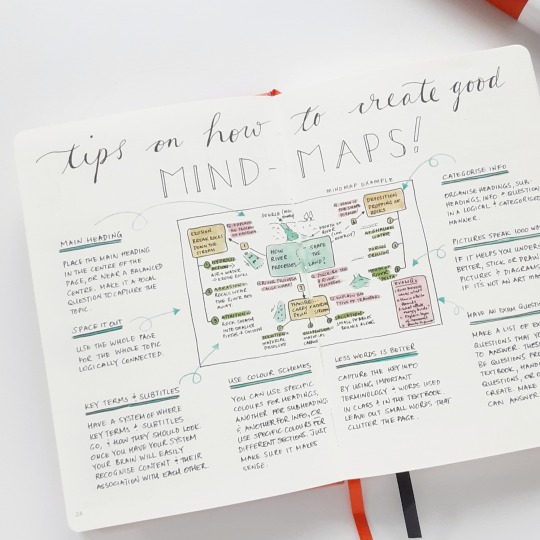
Don't you just love a hand illustrated infographic? TIPS ON HOW TO CREATE GOOD MIND-MAPS was so fun to create. It ended up looking like a boardgame 😋. I'm so pleased that it made it into the QUEST Study Skills Journal! And while I'm on that topic, introducing Saffron Orange! I think it's my favourite option of all the colours. Anyway, back to the #studytips.
1. Have a main heading
2. Space is out
3. Use terms and subtitles
4. Use a colour scheme that makes sense
5. Less words is more
5. Categorise info
6. Pictures pictures pictures
7. Have an exam type questions list
There's more in the fine print in the QUEST Study Skills Journal, which can arrive at your doorstep when you order from the website above 🎉
'Be creatively productive' x
.
.
.
#studying #studyhacks #studyinspo #queststudyskillsjournal #studyjournal #notestaking #studyblr #university #college #queststudyskills #studyinghard #studygram #studygrammer #exams #studyplanner #mindmap #mindmapping #bulletjournal
9 notes
·
View notes
Text

The best part of creating planner spreads in journals is the creative part. Decorating headers and playing around with #washitape. The part I don't enjoy is drawing lines with my ruler. So I created this journal to solve that. I figured other planners disliked the ruler tasks as much as I did. So with these journals all we get to do is be creative and start planning. Are you loving this idea as much as I do? This spread was fun, quick and minimal. The 'before' and 'after'. What do you think?
.
.
.
#study #studying #studyjournal #bulletjournal #plannerspreads #plannernerd #monthlyspread #studyblr #studygram #university #college #studyinspo #studygrammer #queststudyskillsjournal #queststudyskills #getshitdone
0 notes
Photo

6 TIPS FOR NOTE-TAKING FROM TEXT BOOKS AND HANDOUTS: 1. Skim and scan, get the gist. 2. Highlight the key words and important terms. 3. Create exam type question headings. 4. Don't use full sentenses for your notes. 5. Colour code information with a system. 6. Add diagrams. ..... This study hack and a bunch more are in the QUEST Study Skills Journal :) What are your note-taking tips? Do share - let’s co-create on more!
#studying studyhacks studyinspo queststudyskillsjournal studyjournal notestaking studyblr university college queststudyskills studyinghard st#studyblr#study tips#study hard#studyinspo#studygram#studygrammer#queststudyskills#study journal#queststudyskillsjournal#college#university#study notes#notetaking#study hacks
14 notes
·
View notes
Text
HOW TO BE A PLANNER NINJA AND GET STUFF DONE
A simple summary...
1. Have a monthly planner for important assesment dates, due dates, socials, sports etc. This shows busy periods so you can plan accordingly.
2. Have a yearly planner for a very highlevel view of important dates, and busy times of the year.
3. Have a weekly planner for set schedules such as classtimes, specific study review periods per subject you set, homework timeslots, exercise, movie session, gaming et.
4. Have a day planner for your tasks and reminders for each day. Cross them out as you complete each task.
5. Have a project planner for big assignments and projects. Set important dates, milestones and track progress. This is worth more than its weight in paper !
By the way, this planning infographic is available in the QUEST Study Skills Journal pictured here. The journal has readily-available planning templates on faint dot grid pages and 30 pages of study hack illustrations. Check it out on www.queststudyskills.com

#studyblr#queststudyskills#studyspo#university#college#high school#bulletjournal#study journal#study planner#planner addict#study gram#study motivation#study blr#school#queststudyskillsjournal#quest study skills journal
45 notes
·
View notes
Text
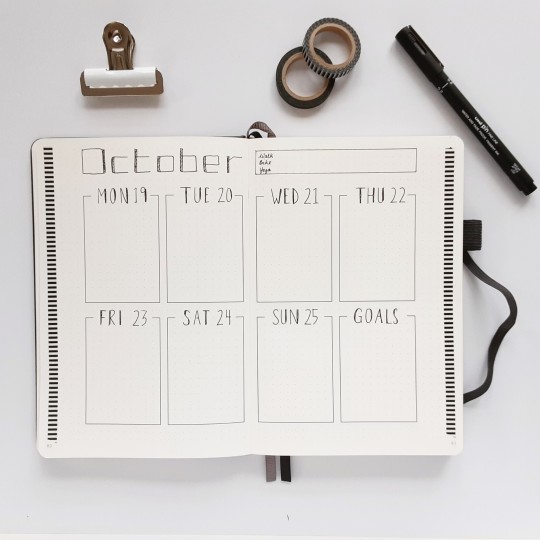
The #bulletjournal spread for the week. The printable for this is downloable from the website if anyone is interested.
How do you feel about drawing lines with your ruler in your #bujo ? Do you find it a chore? I love doing all the creative bits, but urgh, drawing lines.
#studyplanner #studyblr #studyblog #queststudyskills #queststudyskillsjournal #studyinspo #unilife #gettingshitdone #minimalistbulletjournal
3 notes
·
View notes
Text
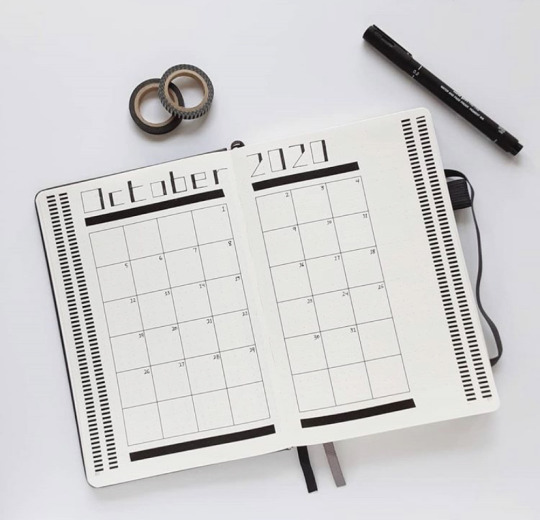
Still active with your #bulletjournal ? Sharing the #octoberspread for 2020 here. What do you think? Isn't it amazing what a bit of #washitape does for a kapow on the page. Love the creativity of creating spreads, but if it takes too long, it defeats the purpose of being productive, dont't you think?
#studyblr#studyspo#study gram#queststudyskills#university#college#study motivation#study blr#bulletjournal#bujo#planner nerd#bujo monthly#school#high school#bullet journal
15 notes
·
View notes
Photo

#100studytips THE FLASH CARD Have you ever created flash-cards to study from? If you have, you're a step ahead of most students. Flash-cards are an amazing study tool for all types of learners... visual, kinaesthetic and auditory learners, as they are so flexible and can be used for many study environments and situations. You can study on-the-go while in transport; make them creative and colourful with pictures and diagrams; and use them is discussions or presentations in group study environments. Here are some simple tips on using flash-cards as a study tool: 1. Create them regularly as you progress throughout the term as you cover new content in classes. Don't wait until a few days before the exam to actually create them. 2. On one side of the card write possible exam questions about a specific topic. Questions about a topic can be in many forms, so write a few options that could be in the exam. On the other side of the card, write the information that answers the question(s). You may need more than one card if there is a lot of information. Try not to cram too much on one card. 3. Use bullet points on the information side. 4. Only use one card for one specific topic or sub-topic. 5. Learn the information week-by-week as you create the cards from new information. By building your knowledge base of the subject as you progress throughout the term helps you understand the whole subject as a whole and how each bit of info relates to each other. This also ensures you don't cram just before the exam. 6. Set aside time in your planner to create the flash-cards, and other times to learn the information. It's easy to forget these two important tasks if it's not in your 'to-do-list'. 7. Study your cards everywhere, as you go to and from school, sitting on the couch, just before bed.. or any time you have idle time. 8. Pretend you're doing a presentation, and present the information to a study buddy or yourself in the mirror. It helps you construct proper sentences from the information. 9. Try to answer the questions you've created on a separate piece of paper without looking at your flash-cards. This helps you create proper sentences with the information, which is what you'll have to do in the exam. 10. This is basic and I'm sure everyone knows this, but I'll add it at the end. Ask a friend or family to test you, by asking you the questions while you answer them verbally. Good luck with those flash-cards.
#100studytips#100 study tips#100 days of productivity#new studygram#new studyblr#study hard#study tip#studying#studyinspiration#study study study#study harder#study notes#flashcards#flash cards#study inspo
215 notes
·
View notes
Photo

#100studytips WAY BETTER THAN ROTE LEARNING (Note: this is semi nerdy)
When it comes to rote learning, there are some benefits and situations where it helps students. Cases such as memorising the times table, new vocabulary of a second language and the periodic table.
But in most cases while we learn throughout our nerd years, learning with comprehension and understanding is the most viable and longer lasting method when it comes to gaining knowledge of subject matter, and applying it to specific tasks, normally assessments such as a test or assignment.
Comprehending information requires us to know the subject matter in relation to how it interacts or is connected to other information we may have learned in the past or may learn in the future. It requires us to critically think about how this new knowledge (sometimes required for a test) impacts on or is affected by other events or possibilities.
Think about events in history. Nothing that has ever happened ‘just happens’. A memorable historical event occurs because something else caused that event to occur. It’s also the same in science and geography. Everything is interconnected somehow in some sort of flow. You could almost create a flow diagram of anything.
How does this help you in school? When you need to remember information for a test, just think:
1. How does this info relate to any other info I have learned? What is the relationship, cause or effect. 2. Can I find out more about the subject matter so I can deepen my knowledge base on it, and therefore understand it better. 3. Why am I learning this? How does it relate to the world around me?
You could honestly come up with a bunch of questions around the topic you are learning. Just keep thinking, why? how? what? when? who? where? It’s all related.
Knowledge is the answer to everything. When you take ownership of learning (uhem, not just rote learn), you empower yourself to do better, and everything you learn has ‘context’ which makes it easier to understand. Well, that’s another topic, really. ..
#study#study blr#studyblr#study tips#100studytips#100 study tips#study hacks#studying#quest study skills#study harder#studying hard#new studygram#studygram#new studyblr
185 notes
·
View notes
Photo
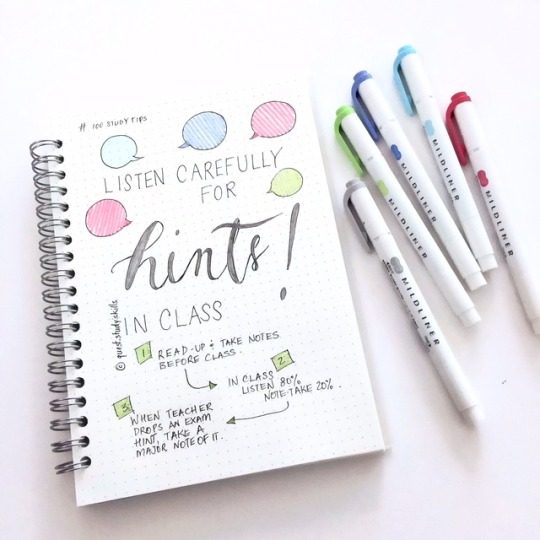
#100studytips LISTEN CAREFULLY FOR HINTS IN CLASS
Have you ever found yourself in a class or lecture so madly and rapidly writing notes that you miss a tonne of what the teacher is saying? And you sometimes have to ask the person next to you so you can ‘get with the program’ …. At this most ordinary juncture, you can forget trying to capture exam hints dropped by the teacher, you are simply in ‘survival mode’!
Apparently learning in class is more effective with the 80/20 rule. That is listen 80% and write 20% of the time. And you’re thinking ‘yeah, right, dream on…’ It is ‘kinda’ challenging and semi-unrealistic to achieve this, but if you actually read-up before class about the topic and prepare your notes (see last posts), you CAN be more chilled, and perhaps achieve a little of the 80/20 rule, in order to pick up on hints and material for exam questions. Some teachers inadvertently drop hints without realising, but if you’re so focused on writing chicken scratch, you would sooo miss those hints. Try this hack and see…
#studying#lecture tips#lecture#class tips#studyblr#Study skills#study tips#study hacks#new studyblr#new study blog#new studygram#studygram#studygranger#study study study#study#study spiration#studystudystudy#studyspo#queststudyskills#100studytips#100 study tips#handlettering#100 days of productivity
1K notes
·
View notes
Photo
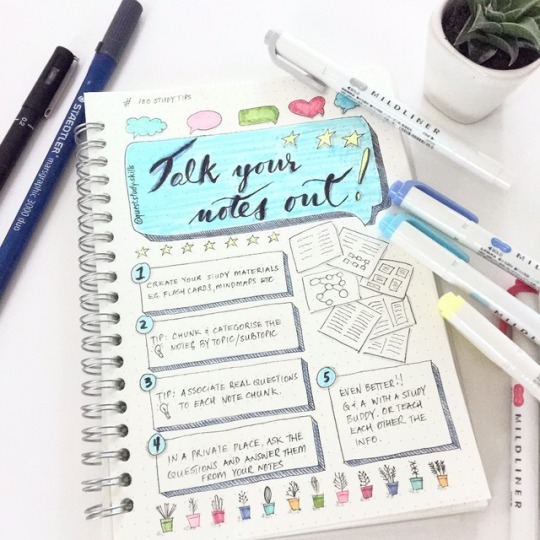
#100studytips TALK YOUR NOTES OUT
When you see people studying they’re normally fairly quiet if not sleeping. This study method may sound a bit odd at first, but it’s a very valuable study hack. Here’s how and why it works.
1. CREATE YOUR STUDY MATERIAL. Just as you normally (well hopefully) would. Create your usual study materials extracted from your messy class and/ or text book notes. eg. flash cards, mind maps, audio notes, diagramed notes etc.
2. TIP. Make sure these study materials are chunked and categorised per topic and sub-topic. This is fairly obvious.
3. TIP. Make sure your study notes are associated and are able to answer and address a number of questions that could be asked. ie. Teacher-type questions that would be found on a test.
4. TALK YOUR NOTES OUT. Go to a private place where you won’t look like a loon. Study your notes, and then recite and talk them out aloud. Because you’re so focused on talking them out correctly, your brain naturally triggers more memory pathways in the brain. It creates a physical context and memory association to the information, which in turn helps when you need to recall that information in a test.
5. EXTRA TIP. Even better than ‘talking your notes out’ is teaching someone else the information. It has a similar effect, but it probably keeps you a lot more focused on the task, because when you’re involving someone else, you inadvertently try even harder and ultimately learn the information even faster and more efficiently.
Hope this is helpful. And happy April !! x
#study blr#studyblr#student#studying#study#studyspiration#studyinspiration#studyinspo#Studygrind#studygram#study gram#study notes#queststudyskills#quest study skills#notebook#Muji Notebook#muji stationary#mildliners#Zebra Sarasa#zebra mildliner#study study study#ways to study#study hacks#study hard#study hack#study habits#Note Taking#revision#new studyblr#new studygram
876 notes
·
View notes
Photo

Just letting you know the 10% off coupon code on stationery supplies such as Mildliners and Milk Sarasa pens and more... from www.kawaiipenshop.com is now simply 'queststudyskills'.. And there's free Int shipping too 👍 Enjoy the shopping ! .
#study#studentlife#student#studyblr#studygram#study blr#study gram#study grind#studying#studystudystudy#stationery addict#muji stationary#kawaii stationery#kawaii#zebra mildliner#mildliners#zebra sarasa#study notes#study supplies#quest study skills#queststudyskills#pen addict#highlighter#notebook#notebooks
255 notes
·
View notes
Photo

Planner squad session using the WEEKLY PLANNER printable. It’s great for planning fixed schedules, printing copies for each individual week, then adding one-off tasks and events for each specific week. Have it stuck up next to the desk AND on the fridge as a reminder 💭😉✨ The mildliners don’t photocopy well, but you can just colour that in while planning. You can get it as a FREE PRINTABLE. Just follow the link in the bio ☝️Enjoy !! . Coloured using zebramildliners and zebrasarasa pen
#zebra mildliner#mildliners#study tip#study hard#studying#study#student life#student#study study study#studyinspo#study hacks#study week#weekly spread#studyblr#studygram#studygrind#100studytips#stationery addict#kawaii stationery#quest study skills#queststudyskills#study all day
620 notes
·
View notes
Photo

SEEKING YOUR THOUGHTS 😉❤️ Happy Monday guys! Just wondering, which notebook do you think looks better for the #100studytips doodles? The bound moleskine or the spiral muji. Well all brands aside… the bound notebook or the spiral notebook? Lol. I can’t work it out which one I like… 🤓 What do you think ? Love your comments ❤️
#zebra mildliner#pentel aquash#moleskineplanner#moleskine sketchbook#muji stationary#muji notebook#stationery addict#100studytips#100 study tips#100 days of productivity#100daysofhandlettering#study tips#study blr#study gram#study hacks#studying#study inspo#study inspiration#mildliners
148 notes
·
View notes
Photo

#100studytips CORNELL NOTES WITH A TWIST
In the last blog post about ‘Cornell Notes’ and how to take them (read bog previous post), I mentioned that I would post a blog about ‘Cornell Notes with a Twist’. Well, here it is... It’s basically the same method as Cornell Notetaking, but there is an added step. Here are the total steps:
1. READ FIRST. Read the chapter or content before the class. Nerdy nerdy but it’s good. Find out what it is, so you can read the info and ‘get with the program’ before the rest of the class.
2. TAKE YOUR OWN NOTES. Once you have read the info, take your own notes in the middle column.
3. ADD KEY WORDS / QUE WORDS / TEACHERY TYPE QUESTIONS. Once you have written your notes, you will have an idea about what the key word or que words etc are. Place these in the columns marked.
4. GO TO CLASS & ADD MORE NOTES. When you turn-up to class, the teacher will cover the content. If there is something new, then you add that content to the class notes column next the related notes you already prepared.
5. ADD MORE INFO. If there is any other info that is of importance, add that.
6. ADD YOUR SUMMARY. Similar to the Cornell Notes method, critically think about the page, and write a summary. This tests you understand the stuff from all angles.
7. ADD YOUR REFLECTION. Similar to the Cornell Notes method, once again critically think about the info on the page, and add a reflection of how you think this info relates to the rest of the unit.
Go forth and conquer.
#studying#student#study hacks#study study study#cornell notes#study gram#study grind#study blr#study tips#100 study tips#Note Taking#notebook#zebra mildliner#mildliners#lecture#lecture tips#notes#study notes#Study skills#study harder#study stress#class notes#moleskine sketchbook#Moleskine#stationery#stationery addict
439 notes
·
View notes
Photo

#100studytips CORNELL NOTES
Have you heard of the Cornell Note Taking system? This note-taking method has been around for ages, but I think the value of it gets forgotten. So I thought I’d give it a bit of a plug today.
It’s a very concise and organised way to compile and collect notes prior to study. Here’s a quick summary of it, but do take the time to research a bit more about it, if you want more info.
1. SPLIT THE PAGE INTO 4. A section at the top for the subject, topic, date etc; a large margin worth 1/3 of the page on the left; a large note-taking section on the right; and finally a space at the bottom for the Summary.
2. WRITE THE ESSENTIALS AT THE TOP. That’s fairly self-explanatory, otherwise notes can get all jumbled.
3. THE NOTES. When in class, write your notes in the Note-Taking Area. Write in point form with bullets, include diagrams, arrows of information relationship, mind-maps, and use abbreviations.
4. KEY WORDS/ CUE WORDS. Once you’ve written the notes, then write the que/key words on the left margin. This is essential, as it makes you critically think about ‘what’ you have actually written. It’s also good to write ‘teacher-type’ questions here. The ones you might find in a test.
5. SUMMARY. In the summary section write a summary (duh obviously) about the notes on the page. This is an important step, as it tests whether or not you know what you just wrote about. If there are holes in the information, and you’re not able to write the summary, then you need to get more info or ask the teacher.
6. REFLECTION. Write a reflection about the information in the summary section too. Focus on how you think this info relates to the rest of the info in the unit, or how it relates to the whole subject in general. This makes you think even more critically about the content, rather than just trying to rote learn like a robot. Sorry.
Next post will be about Cornell Notes with a ‘TWIST’ !! STAY TUNED.
#studying#Study skills#study tips#100studytips#study study study#study hard#study harder#student#study gram#study blr#queststudy#queststudyskills#quest study skills#study hacks#lecture#study notes#notes#Note Taking#cornell notes#notesgram#class notes#lecture notes#bullet journal#bullet journal addict#planner nerd#moleskine#moleskine planner#mildliners#staedtler#staedtler pen
684 notes
·
View notes
Photo

Have you ever been guilty of buying new pens, and then not using them? I was so excited to find these, but I haven't quite worked out how to yet! Gotta try these over the next few #studytips spreads ! Does anyone have any good beginner tips? 😜
#study tip#study blr#study gram#lettering#handlettering#moleskineplanner#moleskine#staedler pens#staedtler#lettering practice#study food
155 notes
·
View notes
Photo

#100studytips Group Study Goals in lettering 📝Wrote a blog post about group study rules in the last post, if you'd like some ideas on getting the most out of studying in a group.. Hope the weekend is going well !! . .
#study tip#study#study hard#study study study#study group#study buddy#study gram#study grind#study blr#studyblr#mind map#mindmap#zebra mildliner#mildliners#moleskineplanner#moleskine sketchbook#moleskine#bullet journal#bullet journal junkies#study inspo#study inspiration#queststudyskills#rockyourhandwriting#100daysofhandlettering
166 notes
·
View notes